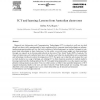126 search results - page 11 / 26 » How well does active learning |
ICML
2005
IEEE
14 years 8 months ago
2005
IEEE
In many domains, a Bayesian network's topological structure is not known a priori and must be inferred from data. This requires a scoring function to measure how well a propo...
CHI
1998
ACM
13 years 11 months ago
1998
ACM
A great deal of effort has gone into developing open-ended inquiry activities for science education as well as complex computer tools for accessing scientific data to help student...
CE
2007
13 years 7 months ago
2007
Research into Information and Communication Technologies (ICT) in schools is well into its third decade but there is still a pressing need to better understand how computer-based ...
FLAIRS
2006
13 years 8 months ago
2006
Lexical Attraction Models (LAMs) were first introduced by Deniz Yuret in (Yuret 1998) to exemplify how an algorithm can learn word dependencies from raw text. His general thesis i...
COGSCI
2007
13 years 7 months ago
2007
Words become associated following repeated co-occurrence episodes. This process might be further determined by the semantic characteristics of the words. The present study focused...

